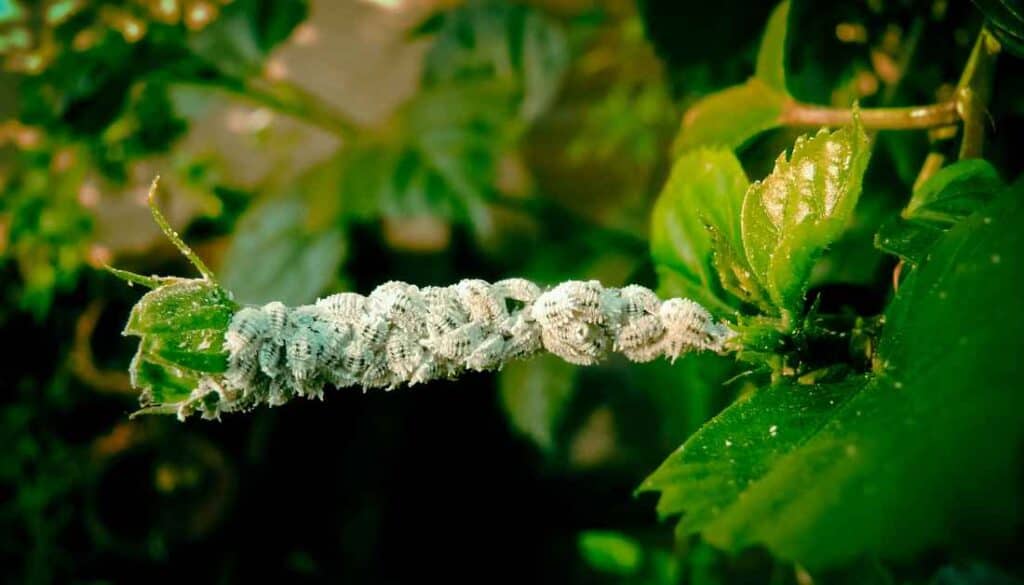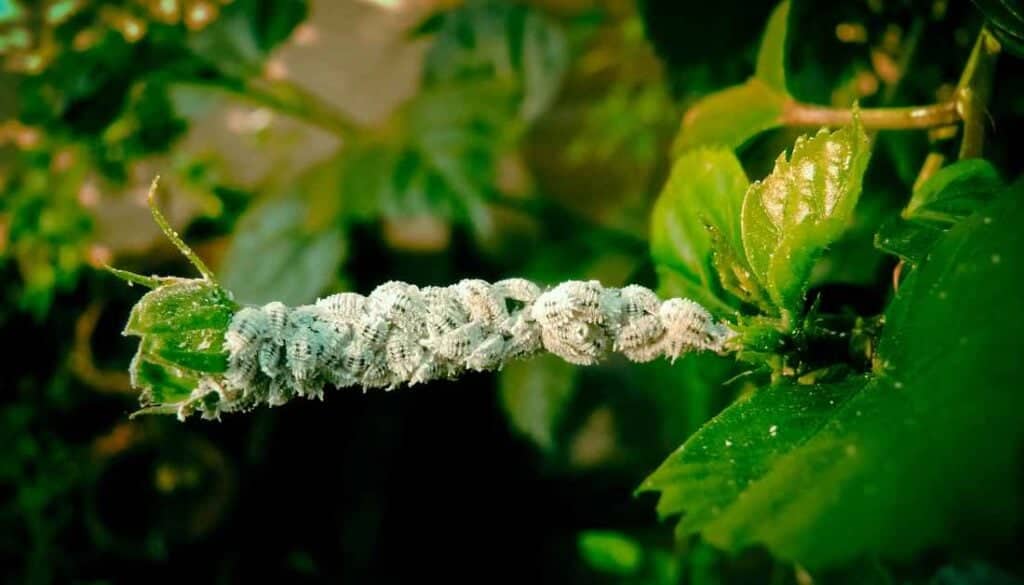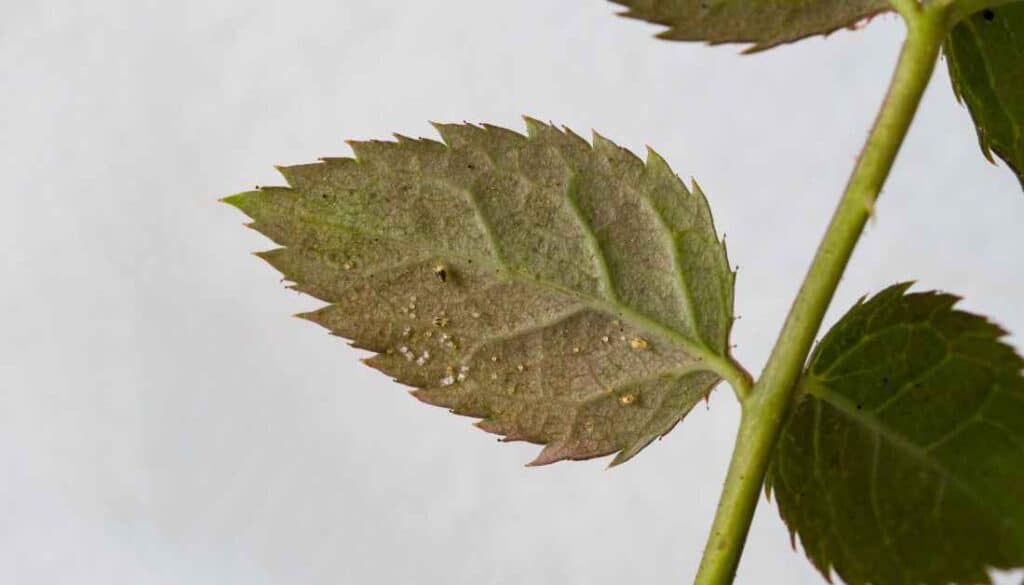Small white bugs on indoor plants look harmless and fuzzy.
But these nasty insects are sap-feeding bugs that make the plants weak.

Too many of them can even kill the plants.
How do I know?
My plants faced the onslaught of these white bugs.
And they inflicted heavy damage on my houseplants and in the greenhouse.
I struggled to identify them because all of them looked similar.
So, I researched and dug deep into what they look like, their species, and the best ways to treat my plants.
I tried a lot of ways to eliminate them. But only a few worked.
In this guide, I will share how I got rid of white bugs on my indoor plants.
I’ll also share the steps I took to prevent them from returning.
Types of Tiny White Bugs on Indoor Plants
Three types of bugs infected my indoor plants –
- Mealy bugs
- White flies
- White mites or spider mites
I also found clear white bugs on the potting soil. Those were soil mites.
But these mites are beneficial insects.
They break down the organic matter in the soil.
That leads to better soil aeration, leading to better plant health.
However, the other three bugs are nasty.
Let’s find out what they look like and the signs of their presence.
Mealy Bugs

Mealy bugs are oval white insects with segmented bodies growing between 1/8 and 1/4 inches.
Mealybugs are flat, and a white waxy coating covers their bodies, giving them a fuzzy, powdery appearance.
These bugs appear as clusters on the plant’s stem and leaves to feed on the plant’s sap.
It leads to stunted growth in plants, yellowing and wilting of leaves.
The worst part is that mealy bugs secrete honeydew.
The honeydew attracts ants to the plants.
And it also turns into sooty molds that prevent the plants from performing photosynthesis.
Whiteflies

Whiteflies are tiny flies, usually less than 1/8 inch long.
They have a distinctive white or pale-yellow body and powdery wings.
When at rest, they hold their wings in a tent-like position over their bodies.
Like mealy bugs, white flies also feed on the plant’s sap. Their feeding causes the same harmful effects.
These flies are hard to find because they hide on the underside of the plant’s leaves.
Whiteflies are weak fliers.
They flutter around a bit when you disturb the plants, and then they settle down.
They’re most active during the daytime. And I noticed them swarming in small clouds around the infested plants.
White flies also leave honeydew, leading to ants and sooty black molds on the plants.
White Mites or Spider Mites

White spider mites were tricky to spot because they were too tiny.
White spider mites are arachnids that grow up to 1/20 inch in size.
These mites look like white dust particles at the undersides of the plants’ leaves.
However, under a magnifying glass, they appeared as tiny white spiders.
When their numbers are low, detecting them with the naked eye is quite challenging.
But I made the mistake of ignoring and underestimating these tiny white arachnids.
These bugs multiplied quickly under room temperature and humidity. And they inflicted severe damage to my greenhouse plants.
When their numbers increased, they left signs like webbings on the plants.
And there was also a dusty layer on the plants’ leaves.
Spider mites also feed on the plant’s sap. As the infestation worsened, the leaves turned yellow, dried up, and dropped prematurely.
Some of these spider mites even ended up on my bed because they spread to my bedroom plants, too.
Treatment of Tiny White Bugs on Indoor Plants

So, after successfully identifying what’s ailing my plants, I went on the offensive.
Here’s what I did to purge these nasty white sap-sucking insects from my plants.
Isolate the Plants
Initially, I was using the bug-killers without isolating my plants.
Big mistake!
The white bugs were jumping over to the nearby healthy plants.
So, I quarantined the plants in a safe, vacant place before treating them.
Ensure Plants are Well-Watered
Plants that are not well-hydrated don’t respond to bug treatment well.
I read that these white bugs avoid healthy plants and specifically target sick and under-watered plants.
So, before the treatment, I watered the plants for two days to ensure they weren’t under any moisture stress.
But remember not to drench the plants.
Doing so will dilute the insecticides you will use, leading to suboptimal results.
Apply Insecticidal Soap

Insecticidal soaps are highly effective in removing white bugs, especially mealy bugs and white mites.
I used a ready-to-use insecticidal soap on my plants.
I used insecticidal soap spray on the plants’ leaves and stems, ensuring the spray made complete contact with the white bugs.
I recommend using the spray on the leaves undersides, too, because white mites and white flies hide there as well.
The undersides of the leaves are tender.
That makes it easy for these white plant bugs to insert their mouth parts to extract the sap.
These white bugs also lay their eggs on the undersides of leaves. And the nymphs hide there, too.
But this is important – read the safety instructions before using the insecticidal soap.
Always confirm that the insecticidal soap is safe for your plant species.
Neem Oil Spray

Neem oil is a proven insect killer. It’s natural, and it has repellent properties, too.
But you’ll have to use it on every part of the plant without skipping any areas.
Mix 2-3 tablespoons of neem in a bottle full of water and pour the mixture into a spray bottle.
Use the spray on the bugs so that it makes direct contact with them.
Cotton Balls Soaked in Rubbing Alcohol
Rubbing alcohol also helps in removing white bugs from the plants. But you’ll need to dilute it.
Mix 1 cup of 70% rubbing alcohol with 1 quart of water.
Then, soak cotton balls or swabs in the mixture.
Dab the soaked cotton ball on the areas of the plants where there are white bugs like mealy bugs and white mites.
Ensure that you’re dabbing the cotton ball or swab on the bugs. It’ll kill those bugs on contact.
However, I found that the dabbing method doesn’t work on whiteflies.
The whiteflies escape the treatment by flying off.
So, it’ll be best to use neem oil spray or insecticidal soap if there are whiteflies on plants.
Chop off The Yellow Leaves
Cutting off the plants’ wilting branches and yellow leaves removes the plants’ damaged portion.
White bugs like mealy bugs, whiteflies, and white mites suck out the sap of the plants.
That leads to plant deformation and symptoms like wilting and yellow leaves.
Take a scissor and prune off the sick or dead parts of the plant.
It’ll significantly reduce the stress on the plants.
Preventing White Bugs on Indoor Plants
Maintaining good plant health and keeping the plants hydrated are keys to preventing white fuzzy bugs on plants.
Bugs target sick plants and plants that are showing signs of stress.
Also, keeping the debris off the plant leaves helps the plants to perform photosynthesis better.
That leads to better plant health.
Inspecting the plants regularly for any signs of bugs and taking prompt action stems from the spread.
I realized that bugs like white flies and woolly aphids infested my outdoor plants.
The flowing winds must have brought them in through the open windows.
So, I also treated my outdoor plants for these pests.
And I didn’t witness any further white bug infestations in my indoor plants ever again.
Another prevention hack that I used to keep bugs off my indoor plants is sticky traps.
I kept one sticky trap on the potting soil of each of the potted plants.
If any fly, such as fungus gnats or whiteflies, targeted my indoor plants, they got stuck on the plant.
I also use repellent like peppermint oil spray on my plants to keep bugs away.
Dish Soapy Spray for White Bugs on Plants
Dish soap spray works by forming a coating on the white bugs. The coating asphyxiates them.
However, I didn’t use dish soap spray because it has low potency and residual effect.
Neem oil and insecticidal spray gave me better results.
Recap
I got rid of white bugs, especially the nasty mealy bugs, from my indoor plants using insecticidal soap and neem oil spray.
However, it’s important to quarantine the infected plants before treating them.
If you don’t, then bugs can jump off to healthy plants.
Also, measures such as keeping the plants clean and well-hydrated are keys to preventing white bugs on plants.
So, now it’s your turn. Have you been struggling with white bugs on plants?
If yes, then what did you do? Let us know in the comments below.
References:
- Whiteflies management guidelines – University of California Agriculture and Natural Resources
- Insect Control: Soaps and Detergents, 5.547 – Colorado State University Extension
- Spider Mites – Houseplant Journal


